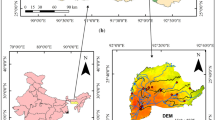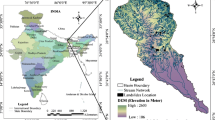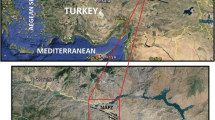Abstract
Landslides and instability slopes are major risks for human activities which often lead to losing economic resources and damaging properties and structures. The main aims of this study are identifying the underlying effective factors of landslide occurrence in Bijar, Kurdistan Province, and evaluating the regions prone to landslide to prepare the susceptibility map using the logistic regression (LR) and analytical hierarchy process (AHP). At first, using field surveys, questionnaires, geological and topographic maps and reviewing the related studies, ten effective factors including the elevation of sea level, slope inclination, slope aspect, geology, distance from the linear elements (fault, road, and river), precipitation and land use were recognized. Then, they were processed using ARC GIS 10 and ILWIS 33. The dependent variable included 144 of slopes prone to landslide selected across the region as the landslide data (code 1), and also 144 stable landslide slopes were randomly selected as landslide free data (code 0). The results of the evaluation showed that LR model with PCPT index equals to 83.4; −2LL index equals to 229.226; and ROC index equals to 98.5% and landslide susceptibility map based on SCAI index had high verification in the case study. Therefore, 75.489% of the area had very low susceptibility, 10.037% low susceptibility, 3.628% moderate susceptibility, 4.062% high susceptibility and 6.784% very high susceptibility. Based on the preferences of the AHP method, the weighting of selected parameters was logically performed so that the parameters could be arranged according to their priorities. The results of the AHP model showed that 3.4% of the area had very low susceptibility, 30.43% low susceptibility, 46.68% moderate susceptibility, 18.14% high susceptibility, and 1.33% very high susceptibility.






Similar content being viewed by others
References
Abedini M, Fathi Jokandan R (2016) Landslide hazard zoning in the Gargan Rood river basin: using Arc GIS. Hydrogeomorpholoy 7:1–17
Akbari A, Yahaya F, Azamirad M, Fanodi M (2014) Landslide susceptibility mapping using logistic regression analysis and GIS. EJGE 19:1687–1696
Atkinson P, Massari R (2011) Autologistic modelling of susceptibility to landsliding in the Central Apennines, Italy. Geomorphology 130:55–64
Ayalew L, Ymagishi H, Marui H, Kanno T (2005) GIS-based susceptibility mapping with comparisons of result from methods and verifications. J Eng Geol 81:432–445
Beladpas A (2009) Landslide hazard zonation in Mako Region to plain bazargan. In: Journal of Geography, Tehran University, Iran, pp 52–66
Bertolini M, Braglia M (2006) Application of the AHP methodology in making a proposal for a public work contract
Burton I, Kates RW (1964) The perception of natural hazard in resource management. Geomorphology 30:412–447
Chau KT, Chan JE (2005) Regional bias of landslide data in generating susceptibility maps using logistic regression for Hong Kong Island. Original Article, pp 280–290
Chau KT, Tang YF, Wong RHC (2004) GIS-based rock fall hazard map for Hong Kong. Rock Mech Min Sci 41(3):1–6
Chen Z, Wang J (2007) Landslide hazard mapping using logistic regression model in Mackenzie Valley, Canada. Geomorphology 42:75–89
Coats DR (1977) Landslide perspectives. Geol Soc Am Rev Eng Geol 3:3–28
Cox DR, Snell EJ (1981) Applied statistics-principles and examples. Chapman and Hall, London
Dai FC, Lee CF (2002) Landslide characteristics and slope instability modeling using GIS, Lantau Island, Hong Kong. J Geomorphol 42:213–228
Das I, Sahoo S, Westen A, Stein A, Hack A (2010) Lanslide susceptibility assessment using logistic regression and its comparison with a rock mass classification system, along road section in the northern Himalayas (India). Geomorphology 114:627–637
Gregory C, Ohlmacher J, Davis C (2003) Using multiple logistic regression and GIS technology to predict landslide hazard in northeast Kansas, USA. Geomorphology 69:331–343
Hong P, Pradhan B, Xu C, Tien Bui D (2015) Spatial prediction of landslide hazard at the Yihuang area (China) using two-class kernel logistic regression, alternating decision tree and support vector machines. Geomorphology 133:266–281
Hosseinzadeh M, Servati M, Mansouri A, Mirbagheri B, Khezri S (2009) Landslide hazard zonation using logistic regression, the way Sanandaj—Dehgolan, Iran. J Geogr 11:27–37
Karam A, Mahmoudi F (2009) Modeling and landslide hazard zonation in Folded Zagros (Sarkhun), Iran. J Geogr 51:1–14
Khamechiyan M, Abdolmalki P, Mazzoni M (2005) Landslide hazard zonation using logistic regression in Sefidargale, Semnan province, Iran. J Geogr 62:65
Kincal C, Akuna A, Koca MY (2009) Landslide susceptibility assessment in the Izmir (West Anatolia, Turkey) city center and its near vicinity by the logistic regression method. Environ Earth Sci. doi:10.1007/s12665-009-0070
Lee S, Min K (2001) Statisical analysis of landslide susceptibility at Yongin Korea. Environ Geol 40:1095–1113
Lydia EE, Daniel B (2002) Land slide hazard and risk zonation mapping in the Rio Grande Basin, Central Andes of Mendoza, Argentina. Mt Res Dev 22(2):177–185
Master plan of Bijar (2007) City of architecture and urban planning consulting engineers Pardiss, Bijar city, Kurdistan province, Iran, p 32
Mirsanei R, Mahdifar M (2006) Methods and optimal criteria for preparing Landslide hazard zonation maps. Center for Natural Disasters, Iran
Mohammadi M (2007) Analysis of mass movements and offer model Region using GIS (case study: Haraz road) M.Sc., Tarbyat Modarss University, Iran, Department of Natural Resources and Marine Sciences, p 79
Mousavi Khatir SZ, Kelarestaghi A, Hashemzadeh Atoei A (2009) Statistical analysis of some morphometric characteristics and effective factors on slope instability in parts of Babolrood watershed. Iran J Water Soil Conserv 16(2):85–103
Nagelkerke NJD (1991) A note on a general definition of the coefficient of determination. Biometrika 78:691–692
Pradhan B (2010) Remote sensing and GIS-based landslide hazards analysis and cross—validation using multivariate logistic regression model on three test area in Malaysia. Adv Space Res 45:1244–1256
Pradhan B, Lee S (2010) Landslide suscepibility assessment and factor effect analysis: backpropagation artificial neural networks and comparison with frequency ratio and bivariate logistic regression modelling Klank valley. Geomorphology 25:747–759
Saaty TL (1990) How to make a decision: the analytic hierarchy process. Eur J Oper Res 48:9–26
Shahabi H, Khezri S, Ahmad B, Hashim M (2014) Landslide susceptibility at central Zan basin. Iran: a comparison between analytical hierarchy processes. Frequency ratio and logistic regression models. Geomorphology 115:55–70
Shirzadi A, Saro L, Hyun-Joo Oh, Chapi K (2012) A GIS-based logistic regression model in rock-fall susceptibility mapping along a mountainous road: Salavat Abad case study, Kurdistan, Iran. Nat Hazard 64:1639–1656
Sweets JA (1988) Measuring the accuracy of diagnostic systems. Science 240:1285–1293
Umar Z, Pradhan B, Ahmad A, Neamah Jebur M, Shafapour Tehrany M (2014) Earthquake induced landslide susceptibility mapping using an integrated ensemble frequency ratio and logistic regression models in West Sumatera Province, Indonesia. Catena 118:124–135
Wang L, Guo M, Sawada K, Lin J, Zhang J (2015) Landslide susceptibility mapping in Mizunami City, Japan: a comparison between logistic regression, bivariate statistical analysis and multivariate adaptive regression spline models. Geomorphology 135:271–282
Yalcin A, Reis S, Aydinoglu AA, Yomralioglu T (2011) A GIS-based comparative study of frequency ratio, analytical hierarchy process, bivariate statistics and logistics regression methods for landslide susceptibility mapping in Trabzon, NE Turkey. Geomorphology 85:274–287
Yeshlnacar E, Topla T (2005) Landslide susceptibility mapping a comparison of logistic regression and neural networks methods in a medium scale (Turkey). Eng Geol 79:2–251
Zhang M, Cao X, Peng L, Niu Ruiqing (2016) Landslide susceptibility mapping based on global and local logistic regression models in Three Gorges Reservoir area, China. Environ Earth Sci 75:958
Author information
Authors and Affiliations
Corresponding author
Rights and permissions
About this article
Cite this article
Abedini, M., Ghasemyan, B. & Rezaei Mogaddam, M.H. Landslide susceptibility mapping in Bijar city, Kurdistan Province, Iran: a comparative study by logistic regression and AHP models. Environ Earth Sci 76, 308 (2017). https://doi.org/10.1007/s12665-017-6502-3
Received:
Accepted:
Published:
DOI: https://doi.org/10.1007/s12665-017-6502-3




